Homepage
of Amber MacNeil
from Clan MacNeil

What's so Special About This Kisimul Castle Anyway?
Kisimul (or Chisimul) Castle gets its name from the Gaelic words cios, (tax or
tribute) and mul (mound), meaning "The place where taxes are paid." Kisimul is a
small medieval castle located in the centre of Castlebay. Construction of Kisimul
Castle was started by Naill of Barra (or Naill of the Castle) 21st of Barra around
1039 AD. Since that time, Kisimul has been the stronghold of Clan MacNeil.
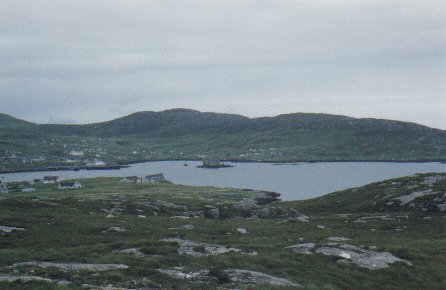
Castlebay, Barra
At almost 1000 years old, Kisimul is one of the oldest castles in europe,
and has
never fallen to an enemy. One of the major reasons for the castle's success as a
stronghold is its position in Castlebay. As Kisimul is completely surrounded by
water, it can only be reached by boat. Although the castle is surrounded by salt
water, it has its own fresh water wells. This supply of fresh water was a major
boon to the inhabitants of the castle. One tale of a siege of the castle by the Norse
tells the story of how the MacNeils fooled the besiegers by hanging up the hides of
cattle that were to be used for the making of shoes. The hides were smeared with
the blood of an unlucky dog, and the Norse were fooled into believing that the Clan
had ample food, so they gave up their siege and went home.
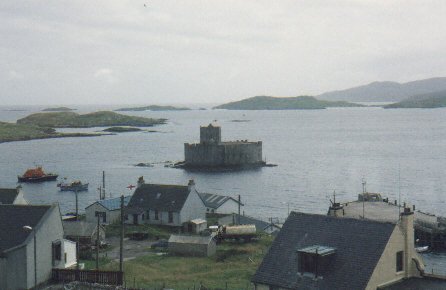
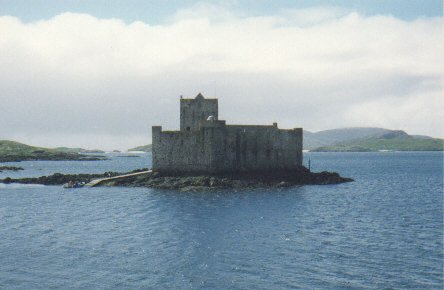
Kisimul Caste - Castlebay, Barra
Kisimul was abandoned in 1838 when the island was sold, the castle was
left to the
mercy of the elements. Partially destroyed by fire and vandals, a large portion of
the castle came to rest on the bottom of the ocean as fishermen used stones from
the castle as ballast for boats. This ballast was thrown overboard to make way for
the catch, and over the years, the castle slowly disappeared.
Robert Lister Macneil 45th of Barra (father of the present Chief of the Clan
MacNeil, Ian Roderick Macneil 46th of Barra) was able to purchase the remains of
the castle and most of the island of Barra in 1937, and he started work to restore
the castle to the way it looked in the 1700's. When Robert Macneil arrived on
Barra, he found the remains of stone fishing jetties surrounding the bay. Using the
stone from these jetties, he restored the castle to its current appearance. This
reconstruction included restoring much of the interior of the castle as well as the
castle's enceinte (or walls).

Kisimul Caste - Castlebay, Barra
In prasing the work of Robert Macneil, one of Scotland's greatest
traditionalists, the
late Sir Iain Moncreiffe of that Ilk said:
"It is often complained that some chiefs have sold their old clan territory
and emigrated. Here is an outstanding example of the reverse; a chief
who devoted his life and fortune to returning from the New World to
rebuild the ruined home of his forefathers."
Kisimul Castle measures approximately one hundred feet in diameter. The enceinte
of the castle are four feet in thickness for the most part but they are about seven
feet in thickness on the east side which is the side nearest the land. The walls are
about fifty feet in height. The walls are topped with a crenelated parapet. Behind
the parapet is a parapet walk about eighteen inches in width. Evidence of old gutter
holes in a lower position of the parapet wall noted by MacGibbon and Ross in their
work Castellated and Domestic Architecture of Scotland (published in 1887) is
evidence that the parapet wall was raised at some point in time to provide an
additional storey. In the upper storey on the north side of the castle's Keep is a
projecting bartizan (a small turret used as a lookout or a defensive platform) over
the entrance door.
The angles of most of the walls are very sharp (arris) at the base with the exception
of the northern angle which is rounded. As the northern angle ascends, it turns into
a small turret with a stance for a sentinel on top. Below the sentinel's stance is a
"dungeon" with what may have been two apartments one above the other. The
lower may have been a prison cell with the upper being a guardroom. The other
angles of the enceinte have been raised higher that the curtain walls, but do not
project out over the curtains to form bartizans. The northwest wall of the enceinte
does have two somewhat rounded projections which may have served as points of
defence for the walls.
The Keep of Kisimul Castle measures approximately twenty nine feet by twenty
seven feet and is carried up from a broadly splayed base. The Keep Tower is
located in the southeast angle of the enceinte, and was added later than the original
construction of the enceinte. The walls of the Keep are about six feet in thickness.
The entrance to the keep is located on the level of the first floor (The second floor
for most North Americans), and when originally constructed could only be entered
by means of a ladder or possibly a movable bridge from the parapet walk. There
are now stairs to this entrance from the castle's courtyard.
The Keep is a total of four storeys in height, with what would have been the Chief's
apartments located above the first floor where the hall was located. The basement
of the Keep would have held the stores for the castle. Stairs from the entrance
level of the Keep run in the thickness of the wall to the basement and to the second
and third floors.
The entrance to the castle it self has changed in that the current steps and doorway
are located to the left of the original position of the castle's gate and machicolation
(an opening in the floor of the parapet walk above the door used for discharging
weapons upon enemies below). In the photograph below, note the the original gate
of the castle was located just to the right of the steps shown.
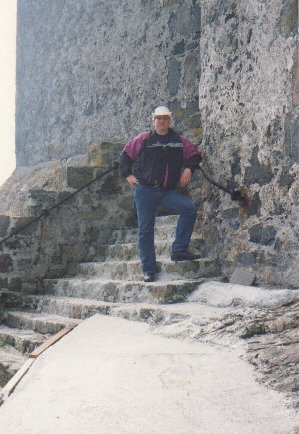
The Entrance to Kisimul Castle
Currently, the restored courtyard of the castle looks like the photo
below. Note the
buildings inside the enceinte were added on as residences some time after the
addition of the Keep. One of the fresh water wells was located in the centre of the
courtyard and can no longer be seen, while the second is located in the right angle
formed by the two buildings located to the right of the photo. At the left of the
photo, a corner of the the Keep of Kisimul Castle can be seen.
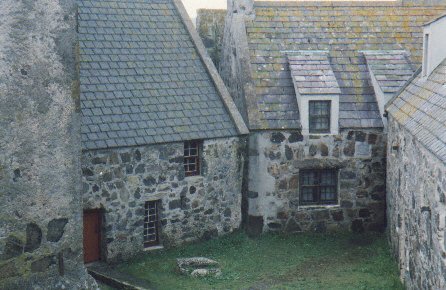
The Courtyard of Kisimul Castle
Information on this page comes from the author's visit to Kisimul Castle
in August of 1997, and is based upon observations made by the author. Other information
comes from conversations with John MacNeill of Barra. All photography is by the author.
Information for this page was confirmed using the following sources:
The Clan Macneil by The Macneil, 45th Chief of the Clan, The Caledonian Publishing
Company, 1923. reprinted by Scotpress, 1985.
Castellated and Domestic Architecture of Scotland by MacGibbon and Ross, 1887